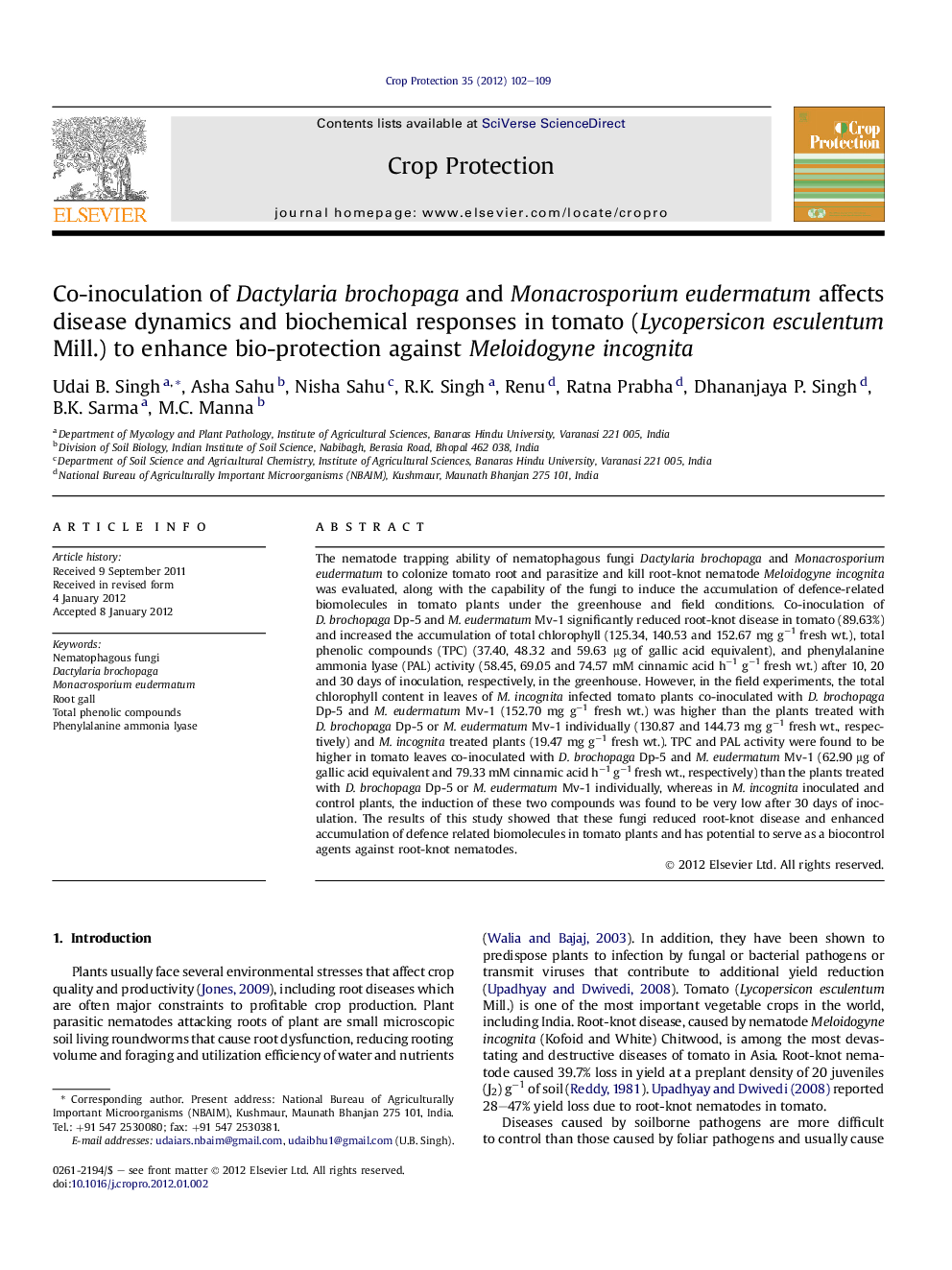| کد مقاله | کد نشریه | سال انتشار | مقاله انگلیسی | نسخه تمام متن |
|---|---|---|---|---|
| 4506525 | 1624352 | 2012 | 8 صفحه PDF | دانلود رایگان |

The nematode trapping ability of nematophagous fungi Dactylaria brochopaga and Monacrosporium eudermatum to colonize tomato root and parasitize and kill root-knot nematode Meloidogyne incognita was evaluated, along with the capability of the fungi to induce the accumulation of defence-related biomolecules in tomato plants under the greenhouse and field conditions. Co-inoculation of D. brochopaga Dp-5 and M. eudermatum Mv-1 significantly reduced root-knot disease in tomato (89.63%) and increased the accumulation of total chlorophyll (125.34, 140.53 and 152.67 mg g−1 fresh wt.), total phenolic compounds (TPC) (37.40, 48.32 and 59.63 μg of gallic acid equivalent), and phenylalanine ammonia lyase (PAL) activity (58.45, 69.05 and 74.57 mM cinnamic acid h−1 g−1 fresh wt.) after 10, 20 and 30 days of inoculation, respectively, in the greenhouse. However, in the field experiments, the total chlorophyll content in leaves of M. incognita infected tomato plants co-inoculated with D. brochopaga Dp-5 and M. eudermatum Mv-1 (152.70 mg g−1 fresh wt.) was higher than the plants treated with D. brochopaga Dp-5 or M. eudermatum Mv-1 individually (130.87 and 144.73 mg g−1 fresh wt., respectively) and M. incognita treated plants (19.47 mg g−1 fresh wt.). TPC and PAL activity were found to be higher in tomato leaves co-inoculated with D. brochopaga Dp-5 and M. eudermatum Mv-1 (62.90 μg of gallic acid equivalent and 79.33 mM cinnamic acid h−1 g−1 fresh wt., respectively) than the plants treated with D. brochopaga Dp-5 or M. eudermatum Mv-1 individually, whereas in M. incognita inoculated and control plants, the induction of these two compounds was found to be very low after 30 days of inoculation. The results of this study showed that these fungi reduced root-knot disease and enhanced accumulation of defence related biomolecules in tomato plants and has potential to serve as a biocontrol agents against root-knot nematodes.
A & B. Hyphal net and trapped nematode (second stage juveniles) by M. eudermatum (600×), C. Constricting ring of D. brochopaga (750×), D. Root knot symptoms on tomato roots.Figure optionsDownload as PowerPoint slideHighlights
► Biocontrol efficacy of D. brochopaga and M. eudermatum was tested against M. incognita.
► D. brochopaga and M. eudermatum were found to have potential for controlling root-knot disease in green house and field trial.
► D. brochopaga and M. eudermatum induce induced systemic resistance in plants against M. incognita.
► We conclude that both of the biocontrol agents having multifarious characteristics could be a cost effective and eco-friendly.
► D. brochopaga and M. eudermatum could be an integral part of integrated disease management.
Journal: Crop Protection - Volume 35, May 2012, Pages 102–109